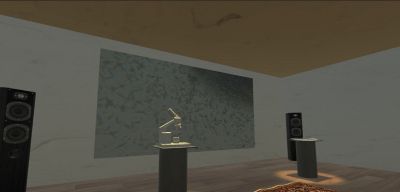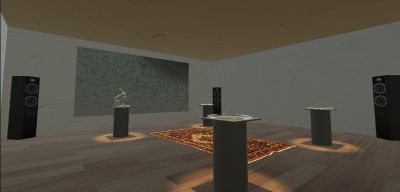GMU:Being a Unicellular Organism/Cosmo Niklas Schüppel: Difference between revisions
| (9 intermediate revisions by 2 users not shown) | |||
| Line 1: | Line 1: | ||
== Being a Unicellular Organism == | |||
2021/2022 | |||
Project and research | |||
Cosmo Niklas Schüppel | |||
== '''common ground''' == | |||
''An participatory installation that aims to create a space for an interspecial connection, inbetween humans and Euglena Gracilis - as equals'' | |||
[[File:common2.jpg|400px]] | |||
[[File:common2.jpg|400px]] | |||
[[File:common1.jpg|400px]] | [[File:common1.jpg|400px]] | ||
== | |||
“Common ground” is a participatory room installation. It creates a space in which the Visitor can connect with the micro-algae Euglena Gracilis through the shared experience of sonic frequencies. | |||
The installation consists of a dimly lit room with shallow glass bowls of E. Gracilis. Live videos of Euglina observed through a microscope will be projected onto the wall. Sonic waves in form of musical drones (monotonous frequencies) will vibrate through the space. | |||
The participator is invited to watch their own inner reaction to the stimulants as well as the reaction of E. Gracilis. How, or if, the micro algae is also responding to the vibrations is left open and up to interpretation. | |||
The goal of the exhibition is to make the visitor aware of their surrounding and their inner workings and movements. | |||
Microorganisms always surround us, they make up a crucial part of our living space and are vital for our survival. Nevertheless they are widely overlooked. ‘Common ground’ is trying to make the unseeable visible and to build bridges into realms where they naked human eye cannot reach. | |||
By confronting the human mind with the monotony of the soundscape, the emotional and thought patterns that sleep within our subconscious are awoken. These thoughts and feelings ‘rebel’ against the stillness. This state of mind has a meditative, trance-like quality to it. It is an invitation to go on a journey of self-inquiry. | |||
Playing with these two contrary directions of sending ones attention - to the algae and to personal thoughts-, ‘common ground’ is a journey inside and outside of the human mind. By this, seemingly contrary perspectives are brought together. Just like the different beings with different principles of perception -humans and micro-algae -are brought together in the installation. | |||
The project is a space to connect, to unite and to find ways in which opposites can meet. And even if they might not interact they can share a space together. Aware of their own and the other’s existence. | |||
The topic of becoming aware of our surrounding and acknowledging other beings (including other humans) as equal to us, is becoming more and more crucial. Problems like climate change and wide spread depression have become unescapable facts. Becoming aware of what happens in and around us is necessary for the well being of us and of the planet. | |||
We are living in a world that drives us into getting lost in objects and problems. One cause of that is hierarchic, patriarchal thinking. This leads to a common feeling of being lost, not grounded, and desolated. Breaking this cycle is necessary to create a world in which we can live respectfully and aware of the existence of others around us. Briefly said, a more empathetic world. | |||
{{#ev:vimeo|662267193}} | |||
The installation features live transmitted video of the organisms under the microscope and a stereo sound system. The drone music, monotonic frequencies without melodies or rhythm, are played from a recording. The visitors and the euglina, have both the same stimulant, to which they do, or don't react. The magnification of euglena is projected on natural fabrics, instead of screens or white walls, to give the video a less digital and more natural feeling. These magnifications are used to show what is also happening in the glass bowls that feature Euglena living in their medium. | |||
Stressed are two perspectives onto E. gracilis (what we see with the naked eye, as well as the magnifications) to make visible that we, as humans, could not even start to understand them in our natural state and to again show the underlying need to understand others, in the human nature. The projection functions as a trigger to set of this instinct, but stands in contrast with the possible non-reactiveness of the cells, that bring the visitor back into their own center of perception. | |||
==Research== | |||
''*for older entries scroll down*'' | |||
===03.01.2022=== | |||
''pre-project research (a summery and conclusion)'' | |||
[[ follow the link to read entry (03.01.2022) ]] | |||
===25.11.2021=== | ===25.11.2021=== | ||
| Line 21: | Line 54: | ||
[[ follow the link to read entry (25.11.21) ]] | [[ follow the link to read entry (25.11.21) ]] | ||
===14.11.2021=== | ===14.11.2021=== | ||
| Line 31: | Line 65: | ||
[[ follow the link to read entry (14.11.21) ]] | [[ follow the link to read entry (14.11.21) ]] | ||
=== 31.10.2021 === | === 31.10.2021 === | ||
Latest revision as of 23:41, 1 June 2022
Being a Unicellular Organism
2021/2022 Project and research
Cosmo Niklas Schüppel
common ground
An participatory installation that aims to create a space for an interspecial connection, inbetween humans and Euglena Gracilis - as equals
“Common ground” is a participatory room installation. It creates a space in which the Visitor can connect with the micro-algae Euglena Gracilis through the shared experience of sonic frequencies. The installation consists of a dimly lit room with shallow glass bowls of E. Gracilis. Live videos of Euglina observed through a microscope will be projected onto the wall. Sonic waves in form of musical drones (monotonous frequencies) will vibrate through the space. The participator is invited to watch their own inner reaction to the stimulants as well as the reaction of E. Gracilis. How, or if, the micro algae is also responding to the vibrations is left open and up to interpretation.
The goal of the exhibition is to make the visitor aware of their surrounding and their inner workings and movements. Microorganisms always surround us, they make up a crucial part of our living space and are vital for our survival. Nevertheless they are widely overlooked. ‘Common ground’ is trying to make the unseeable visible and to build bridges into realms where they naked human eye cannot reach. By confronting the human mind with the monotony of the soundscape, the emotional and thought patterns that sleep within our subconscious are awoken. These thoughts and feelings ‘rebel’ against the stillness. This state of mind has a meditative, trance-like quality to it. It is an invitation to go on a journey of self-inquiry. Playing with these two contrary directions of sending ones attention - to the algae and to personal thoughts-, ‘common ground’ is a journey inside and outside of the human mind. By this, seemingly contrary perspectives are brought together. Just like the different beings with different principles of perception -humans and micro-algae -are brought together in the installation. The project is a space to connect, to unite and to find ways in which opposites can meet. And even if they might not interact they can share a space together. Aware of their own and the other’s existence.
The topic of becoming aware of our surrounding and acknowledging other beings (including other humans) as equal to us, is becoming more and more crucial. Problems like climate change and wide spread depression have become unescapable facts. Becoming aware of what happens in and around us is necessary for the well being of us and of the planet. We are living in a world that drives us into getting lost in objects and problems. One cause of that is hierarchic, patriarchal thinking. This leads to a common feeling of being lost, not grounded, and desolated. Breaking this cycle is necessary to create a world in which we can live respectfully and aware of the existence of others around us. Briefly said, a more empathetic world.
The installation features live transmitted video of the organisms under the microscope and a stereo sound system. The drone music, monotonic frequencies without melodies or rhythm, are played from a recording. The visitors and the euglina, have both the same stimulant, to which they do, or don't react. The magnification of euglena is projected on natural fabrics, instead of screens or white walls, to give the video a less digital and more natural feeling. These magnifications are used to show what is also happening in the glass bowls that feature Euglena living in their medium.
Stressed are two perspectives onto E. gracilis (what we see with the naked eye, as well as the magnifications) to make visible that we, as humans, could not even start to understand them in our natural state and to again show the underlying need to understand others, in the human nature. The projection functions as a trigger to set of this instinct, but stands in contrast with the possible non-reactiveness of the cells, that bring the visitor back into their own center of perception.
Research
*for older entries scroll down*
03.01.2022
pre-project research (a summery and conclusion)
follow the link to read entry (03.01.2022)
25.11.2021
A meeting ground (project idea)
follow the link to read entry (25.11.21)
14.11.2021
A dance to invisible fields (project idea)
follow the link to read entry (b.14.11.21)
Invisible fields (project idea)
follow the link to read entry (14.11.21)
31.10.2021
Ethics of working with living beings
follow the link to read entry (31.10.21)
28.10.21
Euglina Gracilis and Bio-fuels

